Population Geography Notes 12th Geography
12th Geography Lesson 1 Notes in English
1] Population Geography
Introduction
- Do you know that 3,60,000 persons born every day in the world? Four births take place every second in the world.
- ‘Professor Stephen Hawking thinks the human species will have to populate a new planet within 100 years if it is to survive,’ the BBC confirmed. ‘
- With climate change, overdue asteroid strikes, epidemics and population growth, our own planet is increasingly precarious,’ the news outlet continued.
- Human being is an important element of the environment and is probably the latest occupant of the earth, as its evolution took place less than two million years ago.
- Although distribution and growth of human population are influenced greatly by the physical environment, they have tremendous capacity to modify the physical environment.
- Demography is the statistical study of human population.
- It includes the study of size, structure and distribution of population as well as changes in time and location in response to birth, migration, aging and death.
- ‘Population explosion’ is one of the greatest challenges that we are facing today.
Distribution of world population
- People have inhabited the earth for several thousands of years, but for a long period of time, their numbers remained limited.
- It is only during last few hundred years that human population has increased at an alarming rate.
- Population is spread unevenly across the continents.
- Only a few areas support large concentration of people while vast areas support few people.
- A large number of factors influence the distribution and growth of population over the earth’s surface.
The factors influencing the distribution of population
1. Relief
- Rugged mountains pose various obstacles such as unsuitable conditions for the construction of rail-roads and highways, unfavourable conditions for agricultural crops because of short growing season, lack of cultivable land and snowy winters do not encourage large settlement areas.
- Hence, the mountainous areas support a few people.
- On the other hand, a large concentration of population is found in the fertile lowlands such as the Ganges and Brahmaputra in India, Hwang-Ho in China and plains of North-Western Europe and the USA.
- This is mainly due to flat level land which is fertile, favourable conditions for agriculture, long growing seasons and suitable condition for the settlement.
2. Accessibility
- Areas with well developed transport infrastructure and links through road, rail, shipping, canals and air are likely to be more densely populated than areas which are poorly connected with transport network.
- In earlier times, in the absence of water transport, all islands remained virtually uninhabited.
- One of the reasons why mountains are not inhabited by people is lack of accessibility.
3. Adequate water supply
- Population distribution is affected very much by the presence or absence of water in any region.
- Water supply is essential for human survival and development.
- Areas which have sufficient water tend to have denser population than areas which are dry or suffer from regular drought.
- Well watered regions of the Great Northern plains of India are densely populated whereas drought prone areas of Sahara are sparsely populated.
4. Soil
- Fertile alluvial soils of river valleys throughout the world have encouraged dense settlement of population because they support agricultural activities.
- The high density of population in parts of East and South-East Asia is dependent mainly on fertile soil.
- For example, dense population is found in the Ganges valley of India, in Indus valley of Pakistan and Hwang-Ho valley of China.
- On the other hand, desert soil of Sahara region is sparsely populated.
5. Economic and political factors
- Unfavourable economic condition, unemployment, religious intolerance, conflicts and wars do not favour more population.
The patterns of Population Distribution
- The analysis of the pattern of population distribution and density is fundamental to the study of demographic characteristics of any area.
- The population distribution refers to the way the people are spread over the earth’s surface.
- The population distribution is uneven worldwide.
- Ten most populous countries of the world together make up nearly 60% of the world’s population.
Density of Population
- Absolute numbers do not give any indication of the impact of population on the land and its resources.
- The number of persons living per unit of land areas gives a better picture.
- This is expressed in the form of density of population per sq.km of land area.
- It is obtained by dividing the total land area by the total population, the quotient being the number of people per square kilometre.
- Compared with simple arithmetic density, physiological or nutritional density is a more refined method of calculating man-land ratios.
- Physiological or Nutritional density is the ratio between total population and total cropped area.
- The total arable land in the world is 13.3% and the nutritional density of the world is 325 per sq.km of land.
- The total percentage of arable land is 48.83 in India and its nutritional density is 753 per sq.km of land.
- Singapore has the highest nutritional density of population of 440,998 per sq.km of land the world.
- The areas of density of population can be divided into three as follows:
1. High density areas of population
- Fertile plains with favourable climate and highly industrialised and urbanised areas are generally densely populated.
- There are four major areas of high density of population with more than 100 persons per sq.km. Areas include:
- Eastern Asia, including china, Japan and Republic of Korea.
- Southern Asia, comprising India, Bangladesh and Sri Lanka.
- North-Eastern part of the United States of America.
- Central and North-Western Europe.
- Of the four regions given, the first two i.e. Eastern Asia and South Asia have high density of population due to favourable environmental conditions such as favourable climate, fertile soil and large areas of plains which encourage the growth of agriculture.
- The plains and river valleys of India and China are densely populated.
- In the last two groups i.e. North Eastern United States of America and North – Western Europe which are densely populated due to the concentration of manufacturing industries.
2. Moderate density areas of population
- The areas of moderate density of population have between 10 and 80 persons per sq.km.
- The areas of moderate density of population include Central part of the United States of America, Tropical Western Africa, Western blocks of Russia, Eastern Europe, Deccan Plateau of India, Central China, Southern portion of the Plateau of Mexico, North-Eastern Brazil and Central Chile, The above areas are characterised by the well developed agricultural activities, favourable climate, fertile soils, fishing, etc,.
3. Low density areas of population
- About half the area of the world has population less than 10 persons per sq.km.
- Certain vast areas remain completely uninhabited. The main areas are
- Amazon forest region of South America and Congo forest region of Africa.
- Arctic area of Canada, Greenland and the Polar regions.
- Great deserts of the world i.e. Sahara, Kalahari, Arabia, Great desert of Australia, Atacama Desert of South America, desert regions of Western United States and Thar Desert of India.
- High mountainous regions in all continents.
- Antarctica, Australia with an average density of population of 2 persons per sq.km is one of the most sparsely populated countries of the world.
- However, inhabitants of these areas have high standard of living.
- The reasons for low density of population area.
- Bad and unfavourable environment conditions for human settlement.
- Lack of economic activities.
- Lack of transport and communication.
- Government policy.
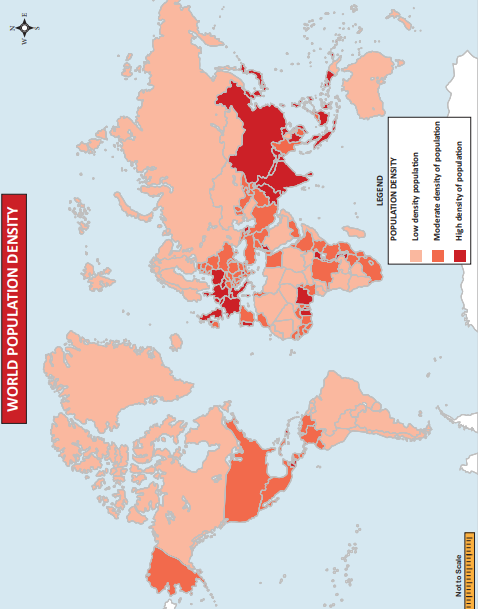
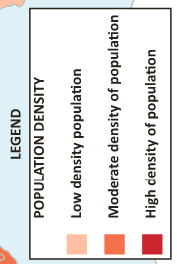
Terms related population
1. Population:
- A group of individuals of the same species occupying a particular geographic area.
2. People:
- The members of a particular nation, community, or ethnic group.
3. Crude Birth rate (Natality Rate):
- Number of live births per thousand people in a year.
4. Crude Death Rate (Mortality Rate):
- Number of deaths per thousand people in a year.
5. Net Migration Rate: the formula for net migration rate is simple:
- N = 1000 × (I – E) / P
- N= net migration rate E= number of people emigrating out of the country
- I= number of people immigrating into the country P= the estimated mid-year population
6. Fertility Rate:
- Is the number of live births expected per 1000 women in their life times in a specified geographic area and for a specific point in time, usually a calendar year.
- Niger has the highest fertility rate of 6.49 while Singapore has the lowest fertility rate of 0.83.
7. Dependency ratio:
- Number of dependents in a population divided by the number of working age people.
- It’s a calculation which groups those aged under 15 with those over 65 years as the ‘dependants’ and classifying those aged 15-64 years as ‘the working-age population’.
8. Growth Rate
- Growth Rate: = CBR – CDR +/- Net Migration Rate/ 1000
- South Sudan has the highest population growth rate of 3.83% in 2017.
9. Rate of Natural Increase (RNI)
- Rate of Natural Increase (RNI) = CBR-CDR (No Migration) CBR>CDR = ↑ population
- RNI usually expressed as % e.g., 2% = 2/100 = 20/1000 RNI ≠ population growth if migration significant
10. Adult Literacy Rate:
- The Adult literacy index (ALI) is a statistical measure used to determine how many adults can read and write in a certain area or nation.
- Adult literacy is one of the factors in measuring the Human Development Index (HDI) of each nation, along with life expectancy, education, and standard of living.
- Burkina faso has the lowest literacy rate of 21.8% (2015).
11. Life expectancy rate:
- Life expectancy equals the average number of years a person born in a given country is expected to live.
- As of 2015, the country with the highest life expectancy is Monaco at 89.52 years; the country with the lowest is Chad at 49.81 years.
Growth of world population
- After the introduction of agriculture about 8,000 to 12,000 years ago, the size of population was small, roughly 8 million.
- In the first century (C.E) it was below 300 million.
- The expanding world trade during the sixteenth and seventeenth century, set the stage for rapid population growth.
- Around 1750, at the dawn of Industrial Revolution, the world population was 550 million.
- World population exploded in the eighteenth century after the Industrial Revolution.
- Technological advancement achieved so far helped in the reduction of birth rate and provided a stage for accelerated population growth.
- The current world population of 7.6 billion is expected to reach 8.6 billion in 2030, 9.8 billion in 2050 and 11.2 billion in 2100, according to a new United Nations report being launched.
- With roughly 83 million people being added to the world’s population every year, the upward trend in population size is expected to continue, even assuming that fertility levels will continue to decline.
- The current world population, according to UN Department of Economic and Social Affairs, Feb, 2019, is 7,685,036,620.
- The new projections include some notable findings at the country level.
- China (with 1.4 billion inhabitants) and India (1.3 billion inhabitants) remain the two most populous countries, comprising 19% and 18% of the total global population respectively.
- In roughly seven years, or around 2024, the population of India is expected to surpass that of China.
- Among the ten largest countries worldwide, Nigeria is growing the most rapidly.
- Consequently, the population of Nigeria, currently the world’s 7th largest, is projected to surpass that of the United States and become the third largest country in the world shortly before 2050.
- Most of the global increase is attributable to a small number of countries.
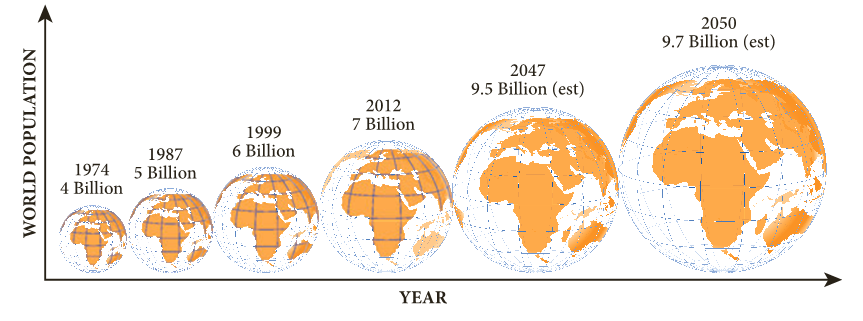
From 2017 to 2050, it is expected that half of the world’s population growth will be concentrated in just nine countries:
- India, Nigeria, Congo, Pakistan, Ethiopia, the United Republic of Tanzania, the United States of America, Uganda and Indonesia (ordered by their expected contribution to total growth).
- The group of 47 least developed countries (LDCs) continues to have a relatively high level of fertility, which stood at 4.3 births per woman in 2010-2015.
- As a result, the population of these countries has been growing rapidly, at around 2.4 % per year.
- Although this rate of increase is expected to slow significantly over the coming decades, the combined population of the LDCs, roughly one billion in 2017, is projected to increase by 33 % between 2017 and 2030, world population will reach 9.7 billion in 2050.
- Similarly, Africa continues to experience high rates of population growth.
- Between 2017 and 2050, the populations of 26 African countries are projected to expand to at least double their current size.
- The concentration of global population growth in the poorest countries presents a considerable challenge to governments in implementing the 2030 Agenda for Sustainable Development, which seeks to end poverty and hunger, expand and update health and education systems, achieve gender equality and women’s empowerment, reduce inequality and ensure that no one is left behind.
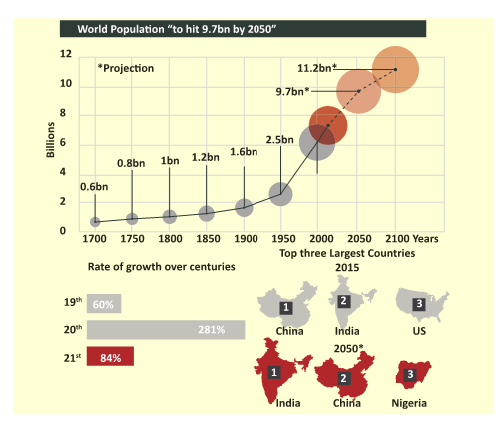
- Population in the world is currently (2019) growing at a rate of around 1.09% per year (down from 1.12% in 2017 and 1.14% in 2016).
- It is estimated to reach 1% by 2023, less than 0.5% by 2052, and 0.25% in 2076. In 2100, it should be only 0.09% or an addition of only 10 million people to a total population of 11.2 billion.
- World population will, therefore, continue to grow in the 21st century.
Doubling Time of population
- Doubling time is the amount of time it takes for a given quantity of population to double in size at a constant growth rate.
- We can find the doubling time for a population undergoing exponential growth by using the Rule of 70.
- It is because the population of a country becomes double in 70 years if the growth rate is 1%.
- Thus, we divide 70 by the growth rate and we get the doubling time of population growth rate.
- For example if the growth rate is 2.08, divide 70 by 2.08 and we get 33.6 years as the doubling time of population.
- World population has doubled in 40 years from 1959 (3 billion) to 1999 (6 billion).
- It is now estimated that it will take another nearly 40 years to increase by another 50% to become 9 billion by 2037.
- The latest world population projections indicate that world population will reach 10 billion persons in the year 2055 and 11 billion in the year 2088.
World Population Milestones
- According to the United Nations, the 6 billion figure was reached on October 12, 1999 (celebrated as the Day of 6 Billion).
- World population reached 7 Billion on October 31, 2011.
- The current world population is 7.7 billion as of Feb 2019 according to the most recent United Nations estimates.
- The United Nations projects world population to reach 8 billion in 2023 and 10 billion in the year 2056.
Regional division on the basis of growth rate
- On the basis of the growth rate of population the world can be divided into the following three types of areas:
1. Areas of Low Growth Rate
- Developed countries like US, Canada, Japan, Australia, New Zealand and countries of western Europe have a low growth rate of population in these countries is due to low birth rates and low death rates.
- The difference between the birth rate and the death rate in these countries is the lowest.
2. Areas of Moderate Growth Rate
- This category includes the developing countries like Pakistan, Afghanistan, Brazil, Bolivia, Mongolia, Indonesia and many other Africa and South American countries, where the growth rate of nearly 2 % is also included among these countries though the growth rate here has started declining.
3. Areas of High Growth Rate
- Countries like Mexico, Iran, Colombia, Venezuela, Peru, Libya, Algeria, Sudan, Kenya and Kuwait make this category.
- In fact, most of the African countries with a growth rate of 3% fall in this category.
Population Concepts
- Over population: situation whereby the population is considered too large for the available resources.
- Under – population: a situation where the population is less than the available resources of a country.
- Optimum – population: a situation where the number of people that can be supported is the same as the available resources.
India – Population
- The current population of India is 1,363,413,725 as of Feb 19, 2019, based on the latest United Nations estimates.
- India population is 17.74% of the total world population.
- India ranks number 2 in the list of countries (and dependencies) by population.
- The population density in India is 455 per Km2.
- 33.6 % of the population is urban (460,249,853 people in 2019)
Composition of Population
- Composition of Population includes sex ratio, literacy rate, age pyramids etc.
Sex Ratio
- The sex ratio is the ratio of males to females in a population.
- Qatar-315 Males per 100 females (2019): With an astounding ratio of 315 males to a 100 females, Qatar holds the number one spot among countries with the highest male to female ratio in the world in 2018.
- As of 2014, the global sex ratio at birth is estimated at 107 boys to 100 girls (1000 boys per 934 girls).
- The sex ratio of India is 933 females for every 1000 males according to 2011.
- Kerala has the highest sex ratio in the country with 1084 females for 1000 males followed by Puducherry with 1037 females for 1000 males and Tamil Nadu with 996 females for 1000 males.
What Are Population Age Pyramids?
- Population pyramids are graphical representations of the age and sex of a population.
- For this reason, population pyramids are also referred to as age-sex pyramids.
- We refer to these graphs as pyramids because they are usually shaped like triangles and population pyramids also take other shapes.
- Population pyramids usually have males on the left side and females on the right.
- There is also a vertical line in the middle of the graph that separates the males from the females.
Latvia, country with the highest sex ratio in the world.
- Latvia is a former Soviet Union country and experienced a great decline in male population during World War two.
- By 2015, there were 84.8 males for every 100 females.
- The proportion of the female was 54.10% of the total population.
- Men in Latvia have a high mortality rate due to issues such as alcoholism, smoking, and careless car driving.
- Around 80% of suicides in Latvia are committed by men, often because of unemployment and unrealized financial goals.
- Women enjoy a longer life expectancy living 11 years more than men.
Literacy Rate
- Total number of literate persons in a given age group, expressed as a percentage of the total population in that age group.
- Literacy rates continue to rise from one generation to the next.
- Yet according to new data from the UNESCO Institute for Statistics, there are still 750 million illiterate adults, two- thirds of whom are women.
- These numbers are a stark reminder of the work ahead to meet Sustainable Development Goals (SDGs) 4 and 5 and the Education 2030 targets.
Literacy rate variations between states in India
- India’s literacy rate is at 74.04%.
- Kerala has achieved a literacy rate of 93.91%.
- Bihar is the least literate state in India, with a literacy of 63.82%.
- Several other social indicators of the two states are correlated with these rates, such as life expectancy at birth (71.61 for males and 75 for females in Kerala, 65.66 for males and 64.79 for females in Bihar), infant mortality per 1,000 live births (10 in Kerala, 61 in Bihar), birth rate per 1,000 people (16.9 in Kerala, 30.9 in Bihar) and death rate per 1,000 people (6.4 in Kerala, 7.9 in Bihar).
- Six Indian states account for about 70% of all illiterates in India: Uttar Pradesh, Bihar, Madhya Pradesh, Rajasthan, Andhra Pradesh and West Bengal.
- Slightly less than half of all Indian illiterates (48.12%) are in the six Hindi-speaking states of Uttar Pradesh, Bihar, Rajasthan, Madhya Pradesh, Jharkhand and Chhattisgarh.
Age – Sex pyramids
- There are three types of Age – Sex pyramids: expansive, constrictive, and stationary.
- Expansive Age – Sex pyramids depict populations that have a larger percentage of people in younger age groups.
- Populations with this shape usually have high fertility rates with lower life expectancies.
- Many third world countries have expansive Age – Sex pyramids.
- Such a population pyramid is a characteristic of newly developing countries such as Afghanistan, Bangladesh, Kenya, and some countries of Latin America.
- Constrictive Age – Sex pyramids are named so because they are constricted at the bottom.
- There is a lower percentage of younger people.
- Constrictive Age – Sex pyramids show declining birth rates, since each succeeding age group is getting smaller and smaller.
- The United States has a constrictive Age – Sex pyramid.
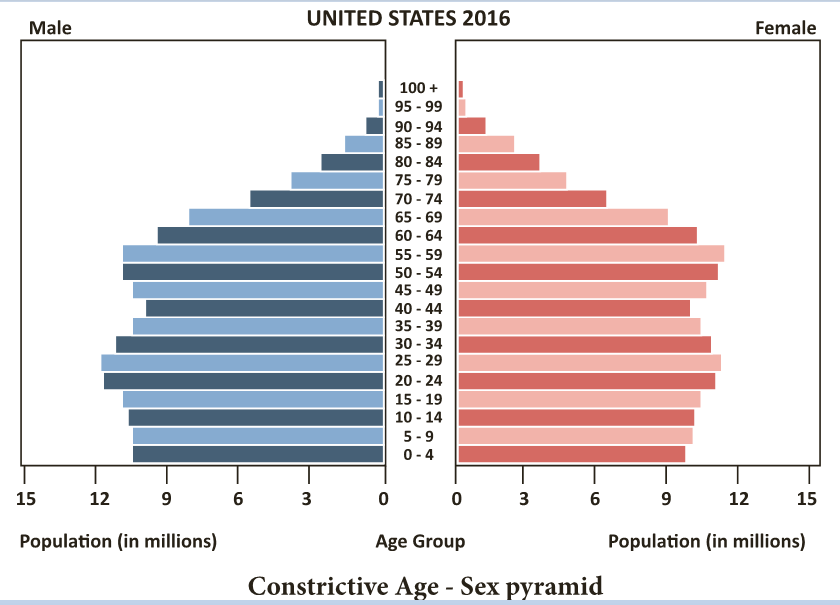
Tripura literacy success
- Presently Tripura has the highest literacy rate in India, 94.65 percent.
- According to the 2011 census, literacy level was 93.91 percent in Kerala and 91.58 percent in Mizoram, among the most literate states in the country.
- The national literacy rate, according to the 2011 census, was 74.04 percent.
- The Tripura success story is attributed to the involvement of local government bodies, including Gram panchayats, NGOs and local clubs under the close supervision of the State Literacy Mission Authority (SLMA) headed by the chief minister.
- Tripura attained 87.75 percent literacy in the 2011 census, from the 12th position in the 2001 census to the 4th position in the 2011 census.
- Among projects implemented by the state government to increase literacy in the state are 10,000 anganwadi centres have 100 percent enrollment.
- Policy of no fail till class VIII to prevent children from dropping out.
- Midday meals in all schools with an eclectic menu for all days of the week to attract more students.
- No tuition fee in government colleges.
- The holistic education system, implemented with equal interest in Agartala, remote areas and the tribal autonomic areas makes sure that people in Tripura do not just become literate but educated, officials emphasized.
- One pointer to the government’s interest in education is the near-total absence of child labour in Tripura.
- Stationary Age – Sex pyramids are those that show a somewhat equal proportion of the population in each age group.
- There is not a decrease or increase in population; it is stable.
- Austria has a stationary Age – Sex pyramid.
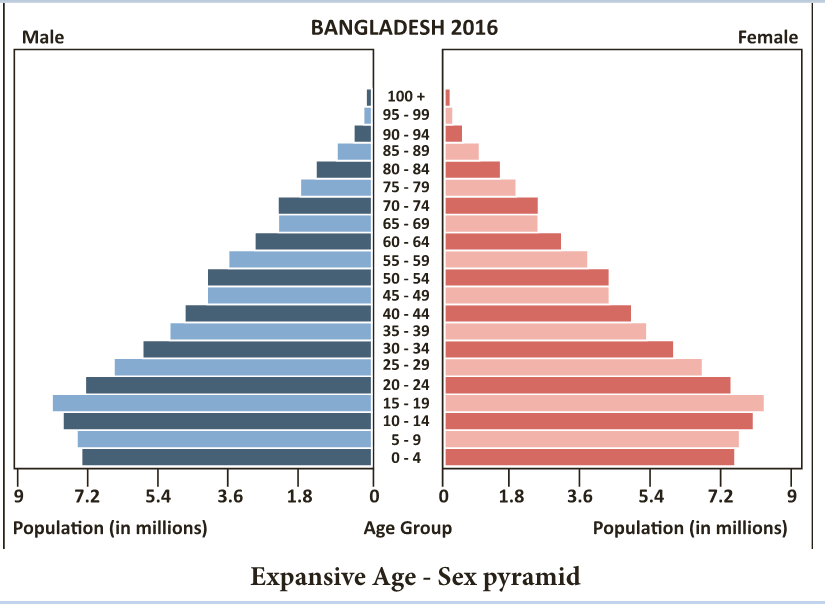
The Purpose of the Age – Sex Pyramid
- The purpose of making this Age – Sex pyramid is to find out the comparison between the number of men and women, the number of workers, and the structure of the population in a country quickly.
- In addition, the creation of the Age – Sex Pyramid also has a purpose to assist the government in taking development policies.
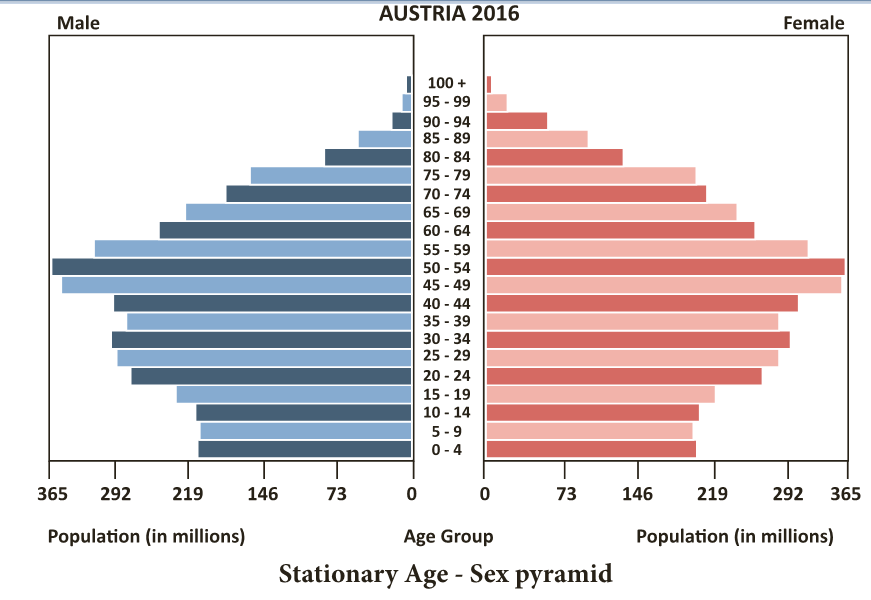
Migration
- Migration means the movement of people from one place to the other.
- It is an important control of population growth after fertility and mortality.
- Migration of people into an area from outside is called immigration or in-migration while movement out of an area to other regions is called emigration or out-migration.
- Immigration leads to an increased growth rate of population, emigration lowers the growth rate of population in the source region.
- Mexico’s emigration problem is a unique one, with more than 98% of all Mexican migrants living in the U.S.A, the country with which Mexico shares a border that runs 3110 km in length.
- The Mexican emigration rate increased substantially since the 1960s and, with more than 11% of Mexicans living abroad, Mexico is the country with the largest number of emigrants in the world.
- According to estimates from the UN 2015 report, in 2013, the United States, Germany and Russia had the largest number of immigrants of any country, while Tuvalu and Tokelau had the lowest immigrant.
Types of migration
1. Net Migration
- Net Migration is the difference between immigration (in-migration) and emigration (out-migration).
- Positive value of net migration is that more people coming in and population growth, for example, 44% of North America and 88% of Europe.
- Negative value of migration is more people coming out and population decline.
2. International Migration
- Emigration is an indicator of economic and or social failures of a society.
- It is a crossing of a national boundary.
- It is easier to control and monitor.
- There are laws to control or inhibit these movements.
- Between 2 million and 3 million people emigrate each year.
- Between 1965 and 2000, 175 million people have migrated: it accounts for 3% of the global population.
3. Internal Migration
- It occurs within a country.
- It is crossing of population within domestic jurisdictional boundaries.
- It is the movement of people between states or provinces.
- There is little government control over internal migration.
4. Local Migration
- Local migration is the migration of the people within state or district.
- No state boundaries are crossed in the local migration.
- It happens for several reasons such as buying a new house in the same town or city, difficult to research since they are usually missed in census data.
- It is based on change of income or lifestyle.
- Americans change residence every 5 to 7 years.
5. Voluntary migration
- Voluntary migration is where the migrant makes the decision to move. Most migration is voluntary.
6. Involuntary migration
- It is a forced migration in which the migrant has no role in the decision-making process.
- It includes mostly slavery.
- It is estimated that about 11 million African slaves were brought to the Americas between 1519 and 1867.
- In 1860, there were close to 4 million slaves in the United States.
- People involve in the involuntary migration are refugees due to military conscription, children of migrants, people in the situations of divorce or separation.
Brain Drain
- Brain drain is related to educationally specific selective migrations.
- Some countries are losing the most educated segment of their population.
- It can be both a benefit for the receiving country and a problem to the country of origin.
- Receiving country: it is getting highly qualified labour which is contributing to the economy right away.
- It promotes economic growth in strategic sectors: science and technology.
- It does not have to pay education and health costs, for example, 30% of Mexicans with a PhD are in the US.
- Country of origin: Education and health costs are not paid back to the country of origin.
- It is losing potential leaders and talent: Between 15 and 40% of a graduating class in Canada will move to the US.
- It has long term impact on economic growth. It has the possibility of getting remittances.
- Many brain drain migrants have skills which they can’t use at home: The resources and technology may not be available there.
- The specific labour market is not big enough.
Causes of Migration
- We can divide factors causing migrations into two groups of factors as push and pull Factors.
Push and Pull factors
- Push and pull factors are those factors which either forcefully push people into migration or attract them.
- A push factor is forceful, and a factor which relates to the country from which a person migrates.
- A pull factor is something concerning the country to which a person migrates. It is generally a benefit that attracts people to a certain place.
- Push and Pull factors are usually considered as north and south poles on a magnet.
- Push Factors: Not enough jobs, few opportunities, desertification, famine/ drought, political fear/ persecution, poor medical care, loss of wealth, natural disasters, death threats, slavery, pollutions, poor housing, landlords, bullying and poor chances of finding courtship
- Pull Factors: job opportunities, better living conditions, political and or religious freedom, enjoyment, education, better medical care, security, family links, industry, better chances of finding courtship.
Overpopulation
- Overpopulation is the state whereby the human population rises to an extent exceeding the carrying capacity of the ecological setting.
- In an overpopulated environment, the numbers of people might be more than the available essential materials for survival such as transport, water, shelter, food or social amenities.
- This regularly contributes to environmental deterioration, worsening in the quality of life, or even the disintegration of the population.
- Due to immigration, the decline in mortality rates, medical breakthroughs, and increased birth rates, populations will always increase and eventually gives rise to overpopulation.
Impacts of Overpopulation
- Overpopulation thus contributes to some of the most compelling environmental problems which encompass:
1. Depletion of Natural Resources
- As human population keeps on increasing, exhaustible natural resources such as arable land, coral reefs, fresh water, fossil fuels, and forests continue to drop sharply.
- This creates competitive demands on the vital life-sustaining resources and contributes to an incredible decline in the quality of life.
2. Accelerated Habitat Loss
- The increased loss of the ecosystems including wetlands, wildlife, rainforests, coral reefs, aquatic life forms, and grasslands are highly influenced by overpopulation.
- For example, rainforests originally covered 14% of the entire earth’s surface.
- Today, rainforest only cover about 6% of the earth’s surface and scientists’ project it may even become less in the next four decades judged by the current rate of vegetation removal, logging, and deforestation.
- Besides, due to environmental pollution, 30% of the ocean reefs have been lost because of acidification and global warming since 1980.
- Also, more than half of the original wetlands have been lost.
3. Amplified Climate Change and Global Warming
- The more the number of people, the more the number of vehicles and industries would be.
- Furthermore, more population tends to increased use of energy sources such as coal and firewood which contributes to increased greenhouse gas emissions.
- Hence, because of the accumulation of human generated green house gases and carbon footprint in the atmosphere, the planet has continued to witness amplified global warming and climate change.
- The effects of climate change and global warming are resulting in extreme hunger, drought, flooding, and loss of habitat.
4. Loss of Biodiversity
- Overpopulation has caused encroachment into frontier forests and destruction of natural ecosystems that has led to the mass extinction of species.
- The number of threatened species persists to multiply in number whereas some have completely gone extinct.
- This is because of human activities such as acidifying water, over exploitation of natural resources, pollution, over fishing, poaching, and destruction of natural systems which are necessary for the survival of different species.
5. Decrease of fresh water
- The unrelenting nature of overpopulation on the earth has destroyed most of the world’s fresh systems.
- Most of the lakes, streams, rivers and ground water making up fresh water have been polluted.
- According to the global outlook of water resources, these activities influenced by over population have only left less than 1% of the planet’s fresh water readily accessible for human utilization.
- Water vulnerability is already affecting many overpopulated nations, especially in some developing countries, as the demands for water tend to be more than the accessible water.
- Millions of fish species from freshwater ecosystems are on the verge of extinction.
- Thus, as human inhabitants rise in number, so will the problem of quality freshwater accessibility.
6. Lower Life Expectancy and Diminished Quality of Life
- Overpopulation lowers the standards of living since it creates stress on the vital resources for survival and increases the difficulty of accessing the consistent supply of quality food, water, energy, health, security and shelter.
- Consequently, it makes the poor to become poorer, and they often opt for poor living conditions to survive.
- Eventually, it gives rise to lower life expectancy.
- The situation is serious in developing nations such as southern Asia and sub-Saharan Africa where most of the poor populations submit to inadequate and poor diets.
7. Rise in Unemployment, Crime Rate, and Violence
- In overpopulated nations, the available jobs are fewer than the overall job seeking population.
- This contributes to high levels of unemployment.
- In turn, lack of unemployment leads to elevated crime rates because of theft, drug cartels, and militia groups which are exploited as options for attaining basic resources and necessities such as food, good living standards, and wealth.
- Violence and conflicts arise when people start competing for the available limited resources.
8. Increased Intensive Farming
- As population has grown over the years, farming practices have evolved to produce enough food to feed larger numbers of people.
- However, intensive farming methods also cause damage to local ecosystems and the land, which may pose problems in the future.
Measures to control overpopulation
- Here are some unique solutions to overpopulation:
1. Creating Awareness Campaigns
- Using both social and mainstream media, we can clearly tell people around the world the truth about overpopulation crises and what must be done to solve them the right way.
2. Promotion of Adopting child
- Adoption become a consideration for family planning, particularly among socially conscientious communities.
- And today, it has become a de-facto solution for people who are interested in starting a family, yet having concerns about overpopulation.
3. Aiming for Single-Child Families
- According to statistics, hundreds of thousands of people are being added to the planet every day, which is an unsustainable rate.
- Hence, it is need of hour we should aim for single-child families.
4. National Security issue
- Over populated countries should treat population boom as an issue of national security.
- As you can see, similar to food insecurity and climate change, uncontrolled and rapid population growth can be a national security threat in a way that it results to instability.
5. Changing Social Norms
- Some couple choose not to have children and we have to respect their decision.
- This way we will be able to help curb the problem of overpopulation.
6. Providing Tax Benefits or Concessions
- Governments of various countries can come up with various regulations and policies related to tax exemption to help solve overpopulation.
- For example, they can waive certain parts of income tax or lower income tax rates for couples who have one or two children.
MORE TO KNOW:
Cisgender
- Cisgender (often abbreviated to simply cis) is a term for people whose gender identity matches the sex that they were assigned at birth.
- It is the opposite of the term transgender.
Glossary
1. Life expectancy: average number of years a person is expected to live.
2. Global warming: unusual increase of earth’s temperature due to the heat trapped in the atmosphere by green house gases. 3. Arable land : land under cultivation.
4. Social Norms: Pattern of behavior in a particular group, community, or culture, accepted as normal and to which an individual is accepted to conform.
5. Overpopulation: population exceeding the carrying capacity of its ecological niche.
6. Worldometers: show estimated current numbers based on statistics and projections from the most reputable official organization.
7. Census: an official count or survey, especially of a population.
8. Gender equality: It is the vision that men and women should be treated equally in social, economic and all other aspects of society, and to not be discriminated against on the basis of their gender.
9. Sustainable development: is a way for people to use resources without the resources running out. 10. Population explosion: a sudden, large increase in the size of a population.
